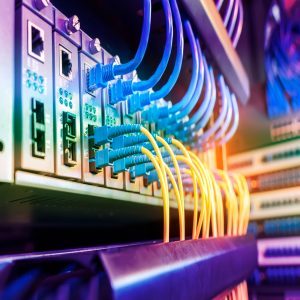Building a network is no small task. It requires the right combination of hardware and software to ensure that it functions properly and securely. When your business, whether large or small, needs to establish a new network it’s important to seek out network support services in your area.
In this blog post, we’ll discuss seven essential devices used to build networks and how they work together to create a secure infrastructure.

Router
The router is the most important device in any network. It connects different networks and controls traffic flow between them.
Routers have built-in security features, such as firewalls, which protect against malicious attacks from outside sources. Additionally, routers can be used to connect multiple wireless access points, allowing you to expand your network’s reach.
Network cards
Network cards are physical hardware components that allow computers or other devices to connect to a network. They come in two main types – wired and wireless – with each having their own advantages and disadvantages.
Wired cards generally provide faster speeds than wireless cards but are limited by the length of the cable connecting them to the router or switch. Wireless cards offer more flexibility with connections but may be subject to interference from other devices on the same network.
Cable
Cables are used for both wired connections between devices and for providing power (such as through an AC adapter). For larger networks, cables can be run underground or through walls in order to provide greater reliability and reduce signal loss due to signal interference.
Cables must meet certain standards in order for them to be approved for use in a network environment. This helps ensure that they will not cause any damage or disruption when connected between different components of a network setup.
Hubs
Hubs are networking devices that allow multiple computers or other devices on the same physical segment of a network (i.e., within range of each other) to communicate with one another without requiring individual cables for each connection point.
Hubs operate at the first layer, or the physical layer, of the OSI model. This means that all data sent over the hub is treated equally regardless of its intended destination on the network (although some hubs do support VLANs). While hubs are still sometimes used in smaller networks, switches are increasingly preferred due to their ability to improve performance by routing data more efficiently than hubs can.
When you’re experiencing technical difficulties with your networking hub, consulting with a professional team that specializes in network support services is ideal.
Bridge
Bridges act as intermediaries between two separate networks by connecting them together at the second layer, or data link layer, of the OSI model. Bridges allow data from one side of the bridge (the source side) to pass the information into another segment of the same local area network (the destination side).
This enables users on either side of a bridge connection to access shared resources on both sides without needing additional cabling or reconfiguration.
Switch
Switches are similar in function to hubs but operate at layer 2, the data link layer, rather than layer 1, the physical layer. As such, they can better manage traffic flow because they recognize which device is being addressed rather than treating all data packets equally like hubs do.
Typically, switches also have more ports than hubs so they can support more connected devices per unit than hubs can. This makes them ideal for creating large networks with many users.
Modem
Modems enable computers and other devices on a local area network (LAN) or wide area network (WAN) to communicate with each other. They convert digital signals from LANs into analog signals that travel over telephone lines. This allows users on different networks that are located far away from one another to access content that is being stored elsewhere.
Modems come in several different types, including DSL modems, cable modems, satellite modems, dial-up modems, fiber optic modems, cellular modems, etc. The type of modem that is being used depends on what type of communication medium is available where you live, work or play.
Trust The Experts at RHYNO Networks For Professional Network Support Services When You Need It
Building a secure and reliable computer or business-based networking infrastructure requires careful consideration of several components. From routers and switches to cables and modems— it’s essential to ensure proper interconnectivity between all elements involved in your system’s architecture.
The experts at RHYNO Networks have a complete understanding of the seven main devices used in building networks, including routers, network cards, cables, hubs, bridges, switches and modems. If you are searching for network support services in King County, WA, you can rely on the expertise at RHYNO Networks. We are well-versed in all things network-related and can navigate any potential issues while ensuring your system remains safe from cyber threats lurking around every corner!
Call our team of IT professionals today and we will have your network running efficiently and effectively!





